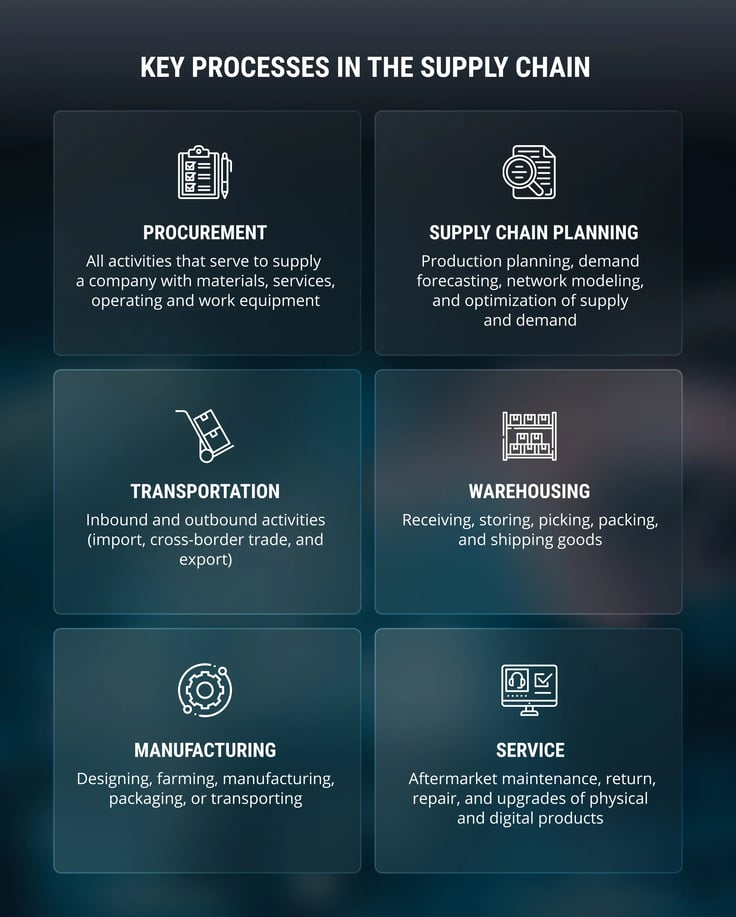What incidents are disrupting supply chains in 2023? Which technologies can be used to combat those disruptions efficiently? The LeverX blog keeps you updated on the world of supply chain management.
Major Supply Chain Disruptions And Comprehensive Software Solutions to Address Them
Imagine a company that relies on a specific supplier for a critical component in its product manufacturing process. Suddenly, the supplier unexpectedly declares bankruptcy. Now, this company will have to quickly find alternative suppliers or negotiate new contracts, which, in turn, will inevitably cause delays in production and potential shortages of the finished product.
Unfortunately, this imaginary situation is an example of multiple disruptions in supply chains and rapidly increasing collateral costs. Companies face numerous challenges simultaneously; continuous crisis management is the new normal.
In this article, we unveil five comprehensive solutions that will empower you to tackle and match supply chain disruptions head-on, ensuring smooth operations, satisfied customers, and a resilient business. Stay tuned to discover the key strategies that will transform your supply chain management and drive success in the face of uncertainty.
What Are the Key Elements in Supply Chain Management?
Before moving on to the market situation and individual cases, determining the area of authority and area of authority is necessary. Supply chain organizations must plan the resources and scope to meet customer needs while optimizing cost, service, inventory, resilience, sustainability, or other goals.

Supply chain management is an important concept for companies because of its great rationalization potential. Substantial capital is tied up in the flow of goods, storage, and transport, causing high costs. There are many interfaces in cooperation with suppliers and customers.
Now let's discuss what market changes trigger supply chain disruptions.
Supply Chain Management Market Overview
The global supply chain management market reached a valuation of about $28.9 billion in 2022, with an estimated potential to reach approximately $45.2 billion in revenue by the conclusion of 2027, exhibiting a promising CAGR of 9.4% from 2022 to 2027.
Several factors propel this growth, including the increasing demand for enhanced visibility and transparency in supply chain operations. Additionally, it is fueled by the rapid expansion of the retail and e-commerce sectors. Furthermore, notable technological advancements within the supply chain industry and the integrating of AI capabilities with SCM products have opened up lucrative opportunities for vendors operating in the SCM market.
However, the market's growth is directly correlated to the growth of the number of problems associated with it.
Top Reasons for Supply Chain Disruptions
Despite positive growth dynamics, companies face supply chain disruptions for many reasons. Two key market changes can lead to supply chain disruptions.

Changing сustomer preferences
Shifting consumer demands, preferences, and trends can significantly impact supply chains. Sudden changes in consumer behavior or preferences result in a mismatch between product availability and demand, leading to disruptions. For example, the sudden popularity of plant-based meat substitutes at one time caught many traditional meat producers and suppliers off guard, which entailed significant losses.
Seasonality and promotions
Seasonal fluctuations or promotional events can create spikes in demand, straining supply chains to meet increased orders within limited timeframes. Inadequate preparation or forecasting for such events can lead to disruptions.
Unforeseen market events
Unexpected market events such as economic downturns, recessions, or disruptions in specific industries can cause significant shifts in demand patterns, affecting supply chain stability. After the notorious COVID-19 pandemic, businesses had to reassess their supply chain strategies to become more agile and connect with customers, suppliers, and other stakeholders.
Supplier issues
Problems with suppliers can cause significant disruptions. Supplier bankruptcies, quality control issues, labor strikes, or raw material shortages can impact the availability and reliability of essential components, materials, or products, leading to disruptions in the supply chain.
An example of a supply chain disruption caused by supplier problems is the 2019 Boeing 737 Max crisis. The manufacturer faced significant supply chain disruptions following two fatal crashes involving the Boeing 737 Max aircraft. The crisis led to the grounding of the 737 Max fleet worldwide, resulting in a halt in production and delayed deliveries.

Trade policies and tariffs
Changes in trade policies, imposition of tariffs, or trade disputes between countries can disrupt established supply chains by increasing costs, introducing new regulatory requirements, or hindering the movement of goods across borders.
Political instability and conflicts
Political instability, civil unrest, or conflicts in certain regions can disrupt supply chains by impeding transportation networks, damaging infrastructure, or causing delays in the movement of goods.
One example of a supply chain disruption caused by political instability and conflicts is the civil war in Syria. The conflict started in 2011 and has significantly impacted regional and global supply chains. Syria was once a major hub for agricultural production, particularly for commodities like wheat. However, the war significantly affected the distribution network. Syria experienced a significant decline in exports in just six years, dropping from approximately $19 billion in 2010 to a mere $555 million in 2016. This decline in exports also resulted in a decline in Syria's global ranking as an exporter, falling from 88th place in 2011 to 141st place in 2015.
Supplier relocation or sourcing changes
When suppliers change locations due to cost considerations, changes in sourcing strategies, or geopolitical factors, it can disrupt established supply chains. Relocating suppliers may introduce logistical challenges, longer lead times, and potential disruptions in production and distribution.
Businesses need to monitor and proactively adapt to these market changes. By implementing effective supply chain management strategies, such as robust forecasting, diversifying suppliers, maintaining agile inventory management, and fostering collaboration with partners, businesses can mitigate the impact of these market changes and enhance supply chain resilience.
Natural disasters
Natural disasters such as earthquakes, hurricanes, floods, or wildfires can damage infrastructure, disrupt transportation networks, and halt production and distribution activities.
A prime example of a supply chain disruption caused by a natural disaster is the impact of Hurricane Katrina in 2005. The hurricane, one of the most destructive in U.S. history, struck the Gulf Coast, particularly affecting Louisiana and Mississippi. The region housed major ports, refineries, and manufacturing facilities crucial to the supply chain for oil and gas, chemicals, and other industries.
This led to significant disruptions in the supply chain that resulted in delays and shortages of essential products like fuel, chemicals, and building materials throughout the entire country. The event exposed the vulnerability of supply chains to natural disasters and highlighted the need for robust contingency plans to mitigate the impact of such disruptions.
How to Combat Supply Chain Disruptions in Practice: Three Common Cases
Case 1: Lack of transparency
When there is no transparency, companies struggle to identify potential bottlenecks, address issues on time, and make informed decisions. Without clear visibility, businesses risk delays, inefficiencies, increased costs, and reduced customer satisfaction, which can significantly impact their bottom line and market competitiveness.
Solution: Seamless integration between business processes
SAP S4/HANA ensures transparency across the entire supply chain through its integrated suite of capabilities. By leveraging real-time data processing and analytics, SAP S4/HANA enables organizations to capture, analyze, and visualize supply chain data in a comprehensive and timely manner. This empowers stakeholders to fully see inventory levels, production status, procurement activities, and logistics operations, enabling proactive decision-making.
The platform's end-to-end transparency facilitates collaboration among suppliers, manufacturers, distributors, and customers, fostering trust and enabling efficient coordination of activities across the supply chain network. SAP S4/HANA's transparency capabilities ultimately empower organizations to enhance operational efficiency, minimize risks, reduce costs, and deliver superior customer experiences.
Case 2: Poor collaboration and data syncing across the supply chain
Lack of effective communication and coordination among suppliers hinders the smooth flow of materials, components, and information, which results in delays, inefficiencies, and inconsistencies. Moreover, without synchronized data sharing, there is a higher risk of errors, misalignment, and discrepancies in inventory levels, production schedules, and demand forecasts. This leads to inaccurate planning and disruptions in the supply chain. Lastly, inadequate supplier collaboration limits visibility and transparency and makes it challenging to promptly identify and address potential issues or risks, amplifying the impact of disruptions when they occur.
Solution: Intelligent digital environment
SAP Digital Supplier Network (SAP DSN) ensures more effective supplier collaboration and streamlines procurement and supply chain processes across the entire supply chain through its integrated platform and suite of tools. By connecting buyers, suppliers, and service providers in a single digital environment, SAP DSN enables seamless communication, collaboration, and data sharing. This fosters real-time visibility into supplier performance, inventory levels, order status, and logistics, which facilitates proactive decision-making and efficient coordination.
With features such as automated procurement workflows, supplier self-service portals, and advanced analytics, SAP Business Network optimizes procurement processes, improves supplier relationship management, and enhances overall supply chain efficiency, ultimately driving cost savings, reducing risks, and delivering superior outcomes.
Case 3: The lack of digitization
Many enterprises, as well as small- and medium-sized companies, experience difficulties with manual and time-consuming processes, such as paper-based documentation, manual data entry, and a lack of real-time visibility. This hampers efficiency, agility, and responsiveness, making it difficult to adapt to changing customer demands, optimize inventory, and collaborate effectively with suppliers.
Furthermore, without digital capabilities, companies struggle to leverage advanced technologies like AI, IoT, and analytics to utilize data-driven insights and make informed decisions. Overall, the absence of supply chain digitization impedes competitiveness, limits scalability, and leaves businesses ill-prepared to navigate the complexities and uncertainties of the modern marketplace.
Solution: A complete digital integration of all systems in real time
SAP Digital Supply Chain facilitates tracking and measuring key environmental metrics, such as carbon emissions, water usage, and waste generation, allowing organizations to identify areas for improvement and implement sustainable practices. Moreover, the platform enhances supply chain resilience by enabling proactive risk management, demand sensing, and scenario planning. This enables organizations to anticipate disruptions, quickly adapt to changes, and maintain continuity despite unexpected events.
With SAP’s Digital Supply Chain Management, you can accelerate time to value by implementing critical supply chain capabilities in a decentralized fashion. This enables you to address immediate disruption threats while taking an incremental journey toward broader transformation with SAP S/4HANA. In other words, your business can start its digital supply chain transformation today, while keeping core enterprise processes stable.
Conclusion
In conclusion, addressing supply chain disruptions and enhancing resilience is crucial for businesses to thrive in today's dynamic landscape. To navigate uncertainties and maintain a competitive edge, it is essential for businesses to proactively implement these comprehensive solutions. Investing in digital transformation and fostering a culture of innovation will be the key to successfully withstand future challenges.
However, it's important to note that supply chain resilience is an ongoing effort. Businesses should continuously monitor, evaluate, and adapt their strategies to evolving circumstances. By staying vigilant, embracing emerging technologies, collaborating with partners, and fostering a culture of continuous improvement, businesses can build resilient supply chains that not only withstand disruptions but also drive sustainable growth in the face of uncertainty.
How useful was this article?
Thanks for your feedback!
.jpg)


